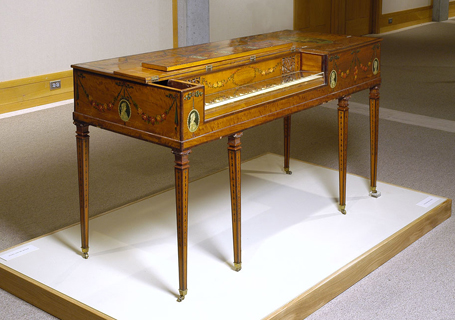
English square piano
ca. 1810
The piano, or pianoforte, is so familiar that its remarkable qualities often go unobserved. Unlike earlier keyboard instruments it can play notes at many gradations of volume in response to how firmly the keys are struck (hence, piano / forte — soft / loud); it can also play many notes simultaneously. The square piano is the direct descendant of the clavichord, but the piano is distinguished by the fact that the strings are struck by hammers rather than “tangents” that stay in contact with the strings (as in the clavichord). It can be played alone, in chamber music, or as a solo instrument in a concerto. It has also been central to the development of jazz and many forms of popular music making for more than two centuries.
The term “square pianoforte” describes an instrument with a horizontal string arrangement (rather than upright), housed in a rectangular case. Invented in the mid-eighteenth century, the square piano became the most common domestic keyboard instrument. Only gradually did the now-familiar upright piano supplant it.
The first significant producer of square pianos in London was Johannes Zumpe, but the firm of John Broadwood & Sons rapidly became synonymous with the instrument, eventually producing more than 1,000 per year in the 1820s. However, the square piano was unable to rival the power and tonal richness of the grand piano, and by the 1850s was overshadowed by more sonorous upright models.
LENT BY THE YALE UNIVERSITY COLLECTION OF MUSICAL INSTRUMENTS
4991.1960
